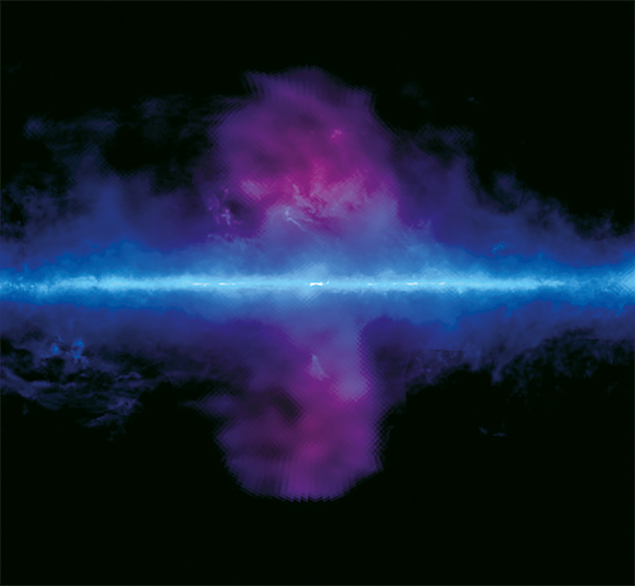
Active galactic nuclei (AGN) are one of the most studied astrophysical objects. Known to be the brightest persistent sources of photons in the radio to gamma- ray spectrum, they are also thought to be responsible for high-energy cosmic rays and neutrinos. As such, they play an important role in the universe and its evolution.
AGNs are galaxies in which the supermassive black hole at their centre is accreting matter, thereby producing violent jets responsible for the observed emissions. While our galaxy has a supermassive black hole at its centre, it is currently not accreting matter and therefore the nucleus of the Milky Way is not active. Strong hints of past activity were, however, discovered using the Fermi–LAT satellite in 2010. In particular, the data showed two giant gamma-ray emitting bubbles – now known as the Fermi bubbles – extending from the galactic centre and covering almost-half of the sky (see image). The exact origin of the giant plasma lobes remains to be understood. However, their position and bipolar nature point towards an origin in the Milky Way’s centre several million years ago, likely during a period of high activity in the galactic nucleus.
A new study led by Trisha Ashley from the Space Telescope Science Institute, Baltimore, brings a fresh perspective on the origin of these structures. Her team focused on the chemical composition of gas clouds inside the bubbles using UV absorption data collected by the Hubble Space Telescope and Green Bank Telescope. Based on their location and movement, these high-velocity clouds had been assumed to originate in the disk of the Milky Way before being swept up as the bubbles were emitted from the galactic centre. However, measurements of the clouds’ elemental makeup cast doubt on this assumption.
UV surprise
Gas clouds from the galactic disk should have a similar chemical composition (referred to as metallicity by astronomers) to those that once collapsed into stars like the Sun. In the galactic disk, the abundance of elements heavier than hydrogen (high metallicity) is expected to be higher thanks to several generations of stars responsible for the production of such elements, whereas in the galactic halo the metallicity is expected to be lower due to a lack of stellar evolution. To measure the chemical composition of the gas clouds, Ashley and her team looked at the UV spectra from sources behind them to see the induced absorption lines. To their surprise, they found not only clouds with high metallicity but also those with a lower metallicity, matching that of galactic halo gas, thereby implying a different origin for these clouds. Suggestions that the second class of clouds is a result of heavy clouds accumulating low-metallicity gases are unlikely to hold, as the time it would take to absorb these gases is significantly longer than the age of the Fermi bubbles. Instead, it appears that while the bubbles did drag along gas clouds from the galactic plane, they also swept up existing halo gas clouds as they expanded outwards.
These results imply that events such as those which produced the Fermi bubbles play an important role in gas accumulation in a galactic plane. They remove gas from the galactic disk, while in parallel, push back gas flowing into the galactic disk from the halo. As less gas reaches the disk, star formation gets suppressed, and as such, these events play an important role in galaxy evolution. Since studying small-scale details such as gas clouds in other galaxies is impossible, these results provide a unique insight into our own galaxy as well as into galaxy evolution in general.
Further reading
T Ashley et al. 2022 Nat. Astron. 6 895.







